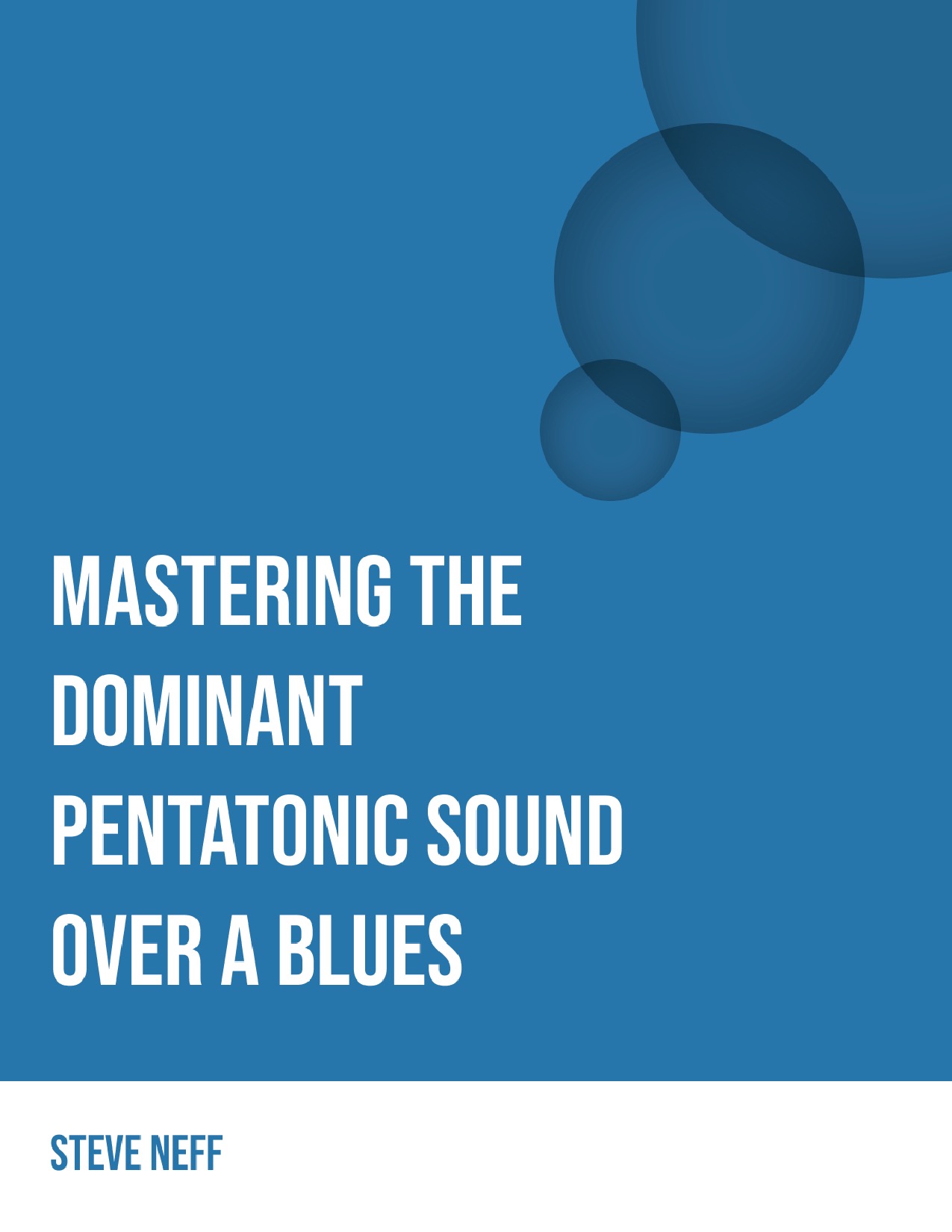Description
“Mastering the Dominant Pentatonic Sound over a Blues” is an exciting new improvisational concept I have been working on over the last few years. This book is a 444 page collection of my work on this dominant pentatonic concept and includes 52 blues exercises in all 12 keys. The book also comes with a 113 minutes video lesson on the background of the concept, tips on how to practice the material as well as some demonstrations of some of the lines on the soprano saxophone.
Here are some examples of what the concept sounds like while improvising on a blues without any accompaniment on the tenor saxophone (there are more examples below). This whole solo is the dominant pentatonic concept but ideally you would obviously want to mix the concept into other concepts for more variation. It is pretty cool what shapes and patterns you can come up with using it………. Let me know if you have any questions. Steve
1.)These are a few one chorus samples from the book of exercises and etudes over the blues using the dominant pentatonic. (Some improv is thrown in on the last half of the clip.)
2.)This is more freestyle improv using the concept over the chords of a blues more freely. All of this is using the dominant pentatonic material with the simple addition of the b3 grace note mixed into the dominant pentatonic to give it a more bluesy effect. Technically, nothing in this 3 minute track is a blues scale although it sure sounds like it. Hope this helps. This is really a powerful concept to get down with a ton of potential!
The origins of this concept came from a lick that I picked up somewhere along my musical journey that I used quite regularly on an F7 chord. I can’t even remember where I got this line from but it is a hip and modern sounding line that I absolutely love that uses the pentatonic scale of F,G,A,C and Eb over an F7 chord. This pentatonic scale is commonly known as the minor 6th pentatonic scale if you were to start it on C but I found that basing the pentatonic off the root of the dominant chord was much easier for me so I relabeled this pentatonic as the “Dominant Pentatonic” which is based off of the root of the dominant chord. I thought that if I dug this line so much, why don’t I try to use the concept it originates from over the whole blues progression and see where that leads.
Mastering the Dominant Pentatonic Sound over a Blues (PDF Digital Download)-19.99
Mastering the Dominant Pentatonic Sound over a Blues (Printed Version)-39.99
I began writing down a variety of patterns using the dominant pentatonic scale and applying them to the blues progression as well as tri-tone substitutions on a blues. I was shocked by how transformed my lines sounded over a 12-bar blues. I was playing ideas and lines I had never played before in over 40 years of playing the saxophone. The lines sound intervallic, flowing and modern. Here are seven examples that I took from my mouthpiece reviews over the last year as I was working on the dominant pentatonic concept using a few of the dominant pentatonic exercises from the book on a blues:
One Chorus of Exercise 1C from the Book and One Chorus Improvisation-Alto Sax (10MFan SuperNova Alto Mouthpiece)
The Same Exercise 1C but Slower with some Improvisation-Tenor Sax (Otto Link Tone Edge Early Babbitt Connoisseur Series Tenor Saxophone Mouthpiece)
Improvisation using the Dominant Pentatonic Concept on a Blues-Soprano Sax with Reverb (Ambika 3 Soprano Mouthpiece)
One Chorus of exercise 1C from the Book and some Improvisation using the concept-Alto Sax (GetASax GS NEW YORK Meyer Bros Alto Saxophone Mouthpiece)
Improvisation using the Dominant Pentatonic concept-Tenor Sax (Johannes Gerber Vintage Slant 7* Tenor Saxophone Mouthpiece)
Improvisation using the Dominant Pentatonic concept mixed in with some other elements-Tenor Sax (Macsax Jalapeño 8* Gold Tenor Saxophone Mouthpiece)
Improvisation using mostly the Dominant Pentatonic concept-Tenor Sax (Lamberson J7 Tenor Saxophone Mouthpiece)
This book is a 444 page collection of my work on this dominant pentatonic concept and includes 52 blues exercises in all 12 keys. The book also comes with a 113 minutes video lesson on the background of the concept, tips on how to practice the material as well as some demonstrations of some of the lines on the soprano saxophone. I think you will find it as transformational as I have. Let me know what you think in the reviews section below once you get some time to work on it! Steve
Mastering the Dominant Pentatonic Sound over a Blues (PDF Digital Version)-19.99
Mastering the Dominant Pentatonic Sound over a Blues (Printed Version)-39.99









Az Samad –
I’ve studied using saxophonist Steve Neff’s material over the years. The cool thing about working with Steve’s material is that it’s always very organized and musical.
This is the case with his latest work, Mastering the Dominant Pentatonic Sound over a Blues.
In his own words:
“Mastering the Dominant Pentatonic Sound over a Blues” is an exciting new improvisational concept I have been working on over the last few years. This book is a 444 page collection of my work on this dominant pentatonic concept and includes 52 blues exercises in all 12 keys. “
The accompanying 73-minute video is an essential part of this eBook as it explains the origin and importance of this sound for him. Besides explaining the theory part, Steve also shares how he came about this particular sound.
In a way, the video puts in context what you’re about to embark on.
As I spent time practicing the material, I got a lot of mileage out of it. For one, I learned a new pentatonic scale that I’ve never explored to this extent. In addition to that I was exposed to Steve’s systematic approach to mastering a concept.
Everything in the book is laid out clearly so that you can get the most out of your practice sessions. I don’t want to reveal too much, but let’s just say that if you dig this sound, you will certainly have more than enough practice ideas to get this into your blues soloing.
The book itself is 452 pages and everything is written out in all 12 keys so that you can just open it up to the key of your choice and start working on the material. Steve also demonstrates different ways you can get deeper with the material so that you don’t get stuck sounding mechanical. The video is key to helping you get the most from this material. I strongly recommend watching the video first before working on the material in the book.
I learned a lot from working on this and am really happy that the written range sits nicely on the guitar too. I do have to mention that since this book is written for all instruments, there is no tablature, everything is in standard notation. That being said, (for guitarists) if you do read standard music notation, you’re gonna get A LOT of good stuff for your practice sessions.
In conclusion, this is a very well written and well organized book. If you find yourself repeating the same typical blues phrases in a twelve bar blues, Steve Neff is here to both take your worries away and make it even more fun for you to improvise on a blues. This book is strongly recommended especially if you already have the more typical blues licks and language under your fingers. This is for those who want to get new ideas but still be in that blues context. Check it out!
Pros: Great material, very well organized and taught with a lot of love.
Cons: None.
TLDR: If you want to get out from more standard approaches to the blues, this book & video set is a good way to get new ideas, shapes, patterns and sounds into your playing.
Az Samad-Guitar Teacher
Paul –
Greetings from England. My copy of your book has arrived and – my goodness! – I’m trying to get my head around the amount of work you’ve put into such a volume. I look forward to incorporating it into my practice; In the meantime, my congratulations to you on such a comprehensive volume of exercises in all 12 keys.
Murray Middleman –
Excellent book for mastering the pentatonic scales in all the keys.
Steve has outdone himself, in the comprehensive amount of ideas and organization in his new book. I highly recommend this book for any serious saxophonist who wants to improve their skills . Congratulations Steve .
Murray Middleman , LosAngeles Saxophonist, Woodwinds Bandleader and Recording Artist
Lloyd Whitty (verified owner) –
I’ve struggled for too many years trying to play chord changes. Even more so with dominant 7 chords. Just like reading a book increases your vocabulary, playing these patterns have given me more to say. This book has increased my playing ten fold. I learn something new new each time I open this book. Thank you so much Steve for helping me learn another language. Musically that is!
Russ –
Hi Steve. I got a copy of your diatonic exercises over a blues progression. Worked hard for a week now on the first set of exercises in the key of C. Excellent. Excellent. I really believe that if I really shred these and improvise different rhythms and so on based on them, then real results on the bandstand will follow. I like to work hard at practicing so I have many, many hours of quality, useful stuff to work on. Thank you for putting this together for us. Now just 11 more keys to go!!!
Andy –
Many thanks, putting these exercises in the context of the blues has made this such an enjoyable book to work through. I’ve abandoned books on patterns before because it was never easy to work out how best to use them and how to link them, but you have answered both of these from the start.
The accompanying video was also a helpful guide, thanks for taking the time to put this together.
You have made some very cold days in the UK winter much more constructive – it’s addictive working on these and hearing the transformation in my playing.
All the best, and many thanks for sharing,
Andy